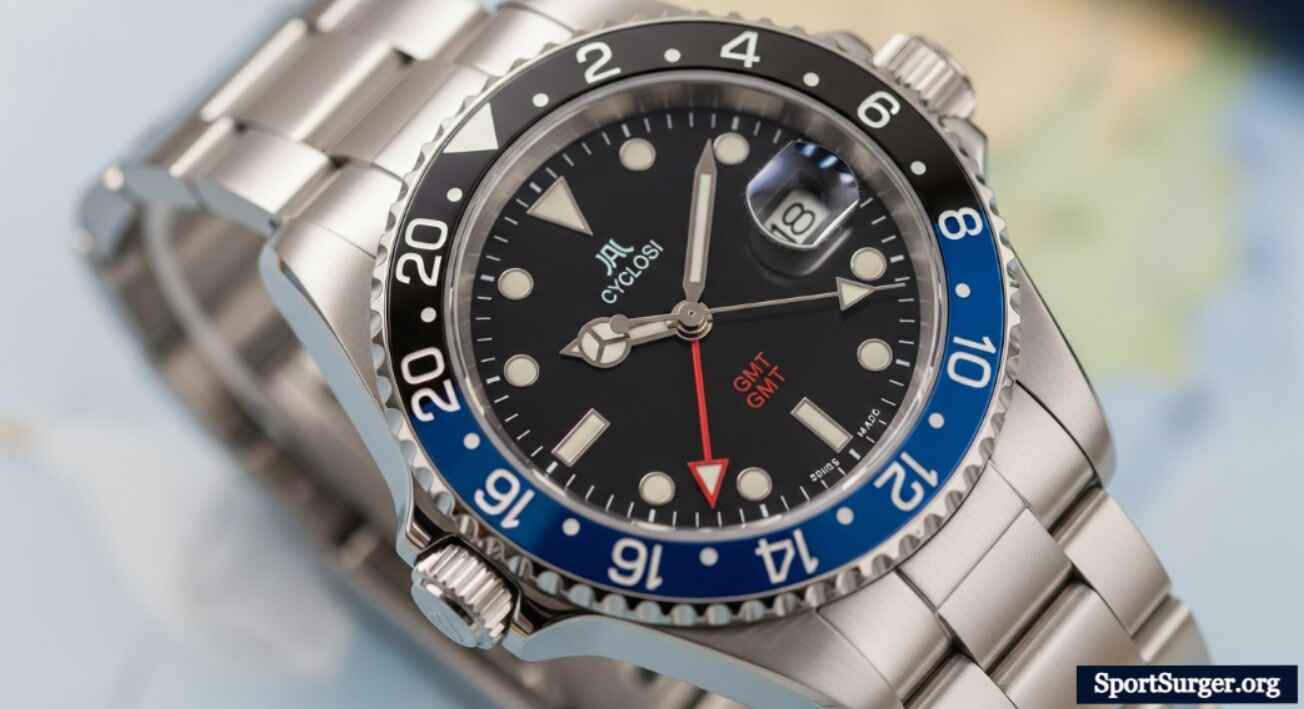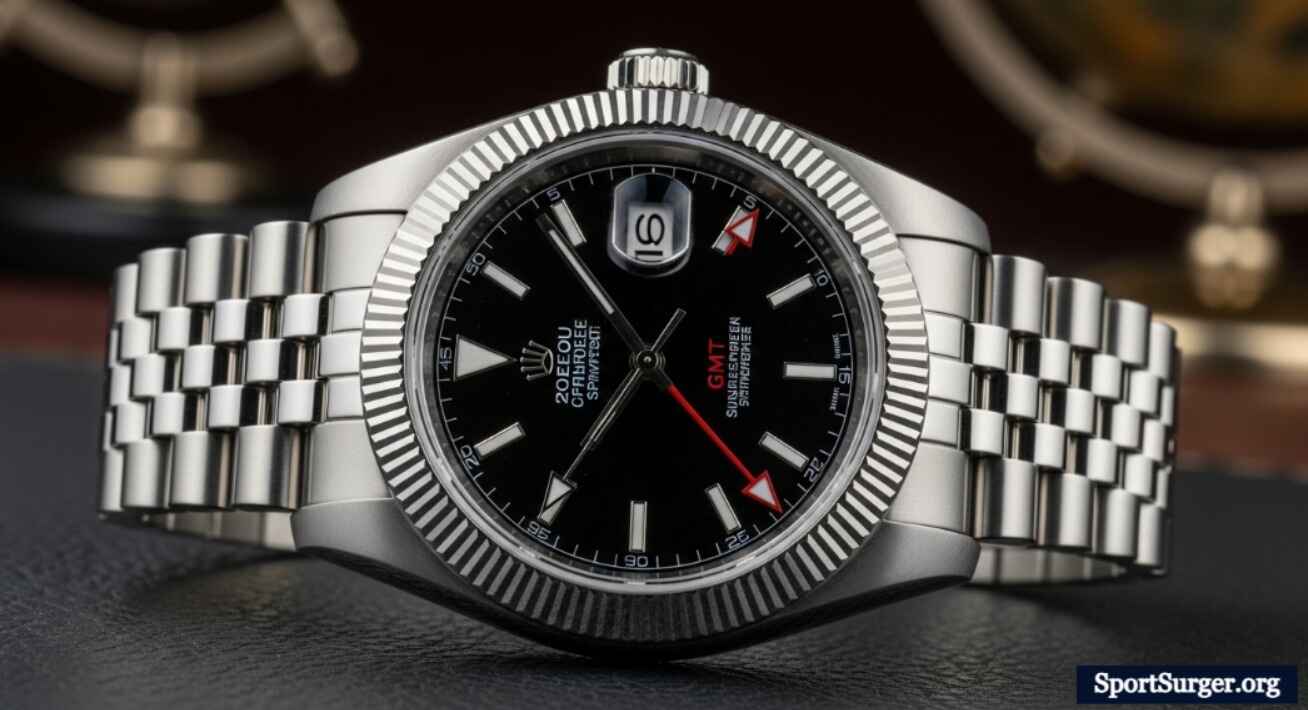Introduction
In a world that never sleeps—where business meetings, travel plans, and communication span across continents—the need to keep track of multiple time zones is more important than ever.
This is where the GMT watch shines as both a practical tool and a symbol of sophistication.
Originally designed for pilots and global travelers, the GMT watch has evolved into a favorite among collectors, professionals, and enthusiasts alike. But what exactly is a GMT watch, and why has it become a timeless staple in horology?
Let’s explore the fascinating history, mechanics, and modern-day significance of GMT watches—and why they remain one of the most functional and elegant timepieces in the world.
What Is a GMT Watch?
A GMT watch is a type of wristwatch that allows the wearer to track more than one time zone simultaneously—most commonly, the local time and a second time zone known as Greenwich Mean Time (GMT).
The Core Functionality
- Primary Hour Hand: Shows local time.
- GMT Hand: Points to a 24-hour scale, representing another time zone.
- Rotating Bezel (optional): Some models feature a 24-hour bezel that allows tracking a third time zone.
In simple terms, a GMT watch helps frequent travelers, pilots, and international business professionals know what time it is both at home and abroad—at a glance.
History of the GMT Watch
The GMT watch concept was born in the 1950s during the golden age of aviation.
The Birth of the GMT Watch
Pan American World Airways (Pan Am) approached Rolex with a challenge: create a wristwatch for pilots that could display both local time and GMT, the standard aviation reference. In response, Rolex developed the Rolex GMT-Master in 1954.
This innovation allowed pilots to coordinate flights across different time zones accurately. Over the years, other brands such as Omega, Breitling, and Tudor followed suit, integrating GMT complications into their designs.
Evolution Over Time
- 1950s–1960s: Introduction of classic GMT watches for professional use.
- 1970s–1980s: GMT watches became popular among global travelers and business executives.
- 2000s–Present: Advanced materials, automatic movements, and multiple time zone tracking capabilities have elevated GMT watches into luxury status symbols.
How Does a GMT Watch Work?

Understanding the mechanics behind a GMT watch enhances appreciation for its craftsmanship.
1. Dual Hour Hands
A GMT watch features two separate hour hands:
- Standard Hour Hand (12-hour format)
- GMT Hour Hand (24-hour format)
The GMT hand rotates once every 24 hours, allowing you to read another time zone directly on the dial or via a rotating bezel.
2. Setting the Time
- Step 1: Set the GMT hand to Greenwich Mean Time or your home time zone.
- Step 2: Set the main hour hand to the local time where you are.
- Step 3: If the watch has a rotating bezel, you can adjust it to track a third time zone.
3. Mechanical and Quartz Movements
While luxury GMT watches often use automatic mechanical movements, there are also quartz GMT models offering affordability and precision.
Why Choose a GMT Watch?
Owning a GMT watch is more than just telling time—it’s about practicality, style, and history.
Practical Benefits
- Track Multiple Time Zones: Perfect for travelers, remote workers, or anyone managing international teams.
- Ease of Use: Quickly adjust local time without resetting the entire watch.
- Reliability: Designed for precision and durability, often featuring robust construction.
Emotional and Aesthetic Appeal
- Symbol of Global Connection: Reflects a lifestyle of travel, curiosity, and sophistication.
- Iconic Designs: Brands like Rolex, Omega, and Tudor have made GMT watches a design statement.
- Collector’s Value: Vintage models often appreciate in value, making them smart investments.
Types of GMT Watches
Not all GMT watches function the same way. They can be broadly categorized into two main types.
1. “Office” GMT Watches
- The GMT hand is adjusted independently, while the main hour hand moves with the minute hand.
- Ideal for people who work across time zones but don’t travel frequently.
Example Brands: Grand Seiko, Longines, Oris.
2. “Traveler” GMT Watches
- The local hour hand can be adjusted independently, allowing quick time zone changes during travel.
- Perfect for jet-setters and pilots.
Example Brands: Rolex GMT-Master II, Tudor Black Bay GMT.
Top Features to Look for in a GMT Watch
When buying a GMT watch, consider these essential features:
| Feature | Description | Why It Matters |
| GMT Hand | 24-hour hand indicating a second time zone | Core function |
| 24-Hour Bezel | Rotatable bezel to track a third time zone | Added versatility |
| Water Resistance | Protection from moisture and dust | Essential for travel |
| Power Reserve | The duration the watch can run without winding | Important for mechanical models |
| Build Quality | Stainless steel, titanium, or ceramic | Determines durability |
| Legibility | Clear dial and luminous markers | Easy to read in all conditions |
Famous GMT Watch Models in History
1. Rolex GMT-Master II
An icon among GMT watches, known for its red and blue “Pepsi” bezel and superior craftsmanship.
2. Omega Seamaster Planet Ocean GMT
A diver’s GMT watch that combines professional-grade durability with elegant design.
3. Tudor Black Bay GMT
A vintage-inspired GMT watch offering remarkable value for its build quality and movement.
4. Grand Seiko Spring Drive GMT
Combines Japanese precision with luxury finishing, featuring the smooth Spring Drive movement.
5. Breitling Avenger GMT
A rugged GMT watch designed for adventure seekers and professionals alike.
GMT Watch vs. World Timer
| Feature | GMT Watch | World Timer |
| Number of Time Zones | 2–3 | Up to 24 |
| Readability | Simple, with 24-hour bezel | Complex, with city rings |
| Best For | Travelers, pilots | Global professionals |
| Ease of Use | Easy to set manually | More advanced mechanism |
Both serve global timekeeping purposes, but the GMT watch remains the more practical choice for most users.
How to Use a GMT Watch Efficiently
For Travelers
- Set the GMT hand to your home time zone.
- Adjust the main hour hand to your current location.
- Use the bezel to track an additional time zone if needed.
For Business Professionals
- Keep the GMT hand set to your colleague’s or client’s time zone.
- Avoid missed calls or meetings by always knowing their local time.
For Collectors
- Learn to identify first-generation movements or rare bezel variants, which often hold higher resale value.
GMT Watch Maintenance Tips
Proper care ensures your GMT watch remains accurate and beautiful for years.
- Service Regularly: Mechanical models typically require servicing every 3–5 years.
- Avoid Magnetism: Keep your watch away from strong magnetic fields.
- Clean Gently: Use a soft microfiber cloth to clean the case and bracelet.
- Store Safely: Use a watch box or winder to prevent scratches.
- Check Water Resistance: Have gaskets inspected if you use it for swimming or diving.
Modern Trends in GMT Watches
1. Sustainable Materials
Brands are increasingly using recycled metals and vegan straps to appeal to eco-conscious buyers.
2. Smart GMT Watches
Some smartwatch models now integrate digital GMT functions, allowing travelers to switch time zones automatically.
3. Microbrand Innovations
Smaller watchmakers are designing affordable GMT watches with impressive craftsmanship, expanding accessibility beyond luxury markets.
Expert Insights: Why Horologists Love the GMT Watch
Horology experts agree that the GMT watch represents the perfect blend of form and function.
“A GMT watch embodies the spirit of travel and precision engineering—it’s more than just a tool; it’s a bridge between time zones and people,” says a veteran watchmaker from Geneva.
Collectors value them for their historical lineage, while professionals admire their usability and mechanical ingenuity.
How to Choose the Right GMT Watch
When selecting the perfect GMT watch, consider:
1. Purpose
- Frequent Traveler: Opt for a traveler GMT with independent hour hand adjustment.
- Desk Professional: Choose an office GMT with elegant styling.
2. Movement Type
- Mechanical: Traditional craftsmanship and prestige.
- Quartz: Accuracy and affordability.
3. Budget Range
- Entry-Level: Citizen, Seiko, Orient.
- Mid-Range: Tudor, Oris, Longines.
- Luxury: Rolex, Omega, Grand Seiko.
4. Design Preference
Decide between classic, sporty, or modern minimalist aesthetics depending on your lifestyle.
Common Myths About GMT Watches
Myth 1: Only pilots need GMT watches.
Truth: They’re useful for anyone dealing with multiple time zones.
Myth 2: GMT watches are too complex to use.
Truth: Modern designs are intuitive and easy to set.
Myth 3: All GMT watches are expensive.
Truth: There are reliable options across all price categories.
Conclusion
From the skies to the wrists of collectors, the GMT watch has stood the test of time—literally and symbolically. Its dual-time functionality, rich history, and elegant craftsmanship make it a true icon in horology.
Whether you’re a world traveler business professional, or passionate watch enthusiast, a GMT watch doesn’t just tell time—it tells your story across the globe.
In the evolving world of timekeeping, the GMT watch remains a beacon of precision, purpose, and timeless design.

